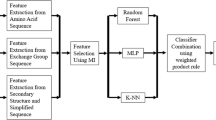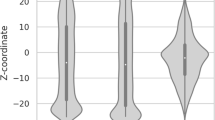Abstract
Prediction of protein secondary structure is considered to be an important step toward elucidating the three-dimensional structure and function of proteins. We have developed a multimodal neural network (MNN) to predict protein secondary structure. The MNN is composed of several subclassifiers for single-state predictions using neural networks and a decision neural network (DNN). Each subclassifier employs a number of subnetworks to predict the single-state of the secondary structure individually and produces the final results by majority decision. The DNN uses a three-layer neural network to produce the final overall prediction from the outputs of the single-state predictions. The MNN gives an overall accuracy of 71.1% with corresponding Matthews correlation coefficients of CH = 0.62 and CE = 0.53. The prediction test is based on a database of 126 nonhomologous protein sequences.
Similar content being viewed by others
Explore related subjects
Discover the latest articles, news and stories from top researchers in related subjects.References
Kneller DG, Cohen FE, Langridge R (1990) Improvements in protein secondary structure prediction by enhanced neural networks. J Mol Biol 214:171–182
Rost B, Sander C (1993) Prediction of protein secondary structure at better than 70% accuracy. J Mol Biol 232:584–599
Jones DT (1999) Protein secondary structure prediction based on position-specific scoring matrices. J Mol Biol 292:195–202
Yoshihara I, Nakagawa T, Yasunaga M, et al. (1982) A multimodal neural network using Chebyschev polynomials. Proceedings of the 13th Korea Automatic Control Conference (KACC’98) pp 250–253
Nakagawa T, Inaba M, Sugawara K, et al. (1999) An application of multi-modal neural network to multiple control system. Proceedings of the 4th International Symposium on Artificial Life and Robotics (AROB-4) pp 737–740
Yoshihara I, Nakagawa T, Yasunaga M, et al. (1999) A multimodal neural network using Chebyschev polynomials and its application. Proceedings of 1999 International Joint Conference on Neural Networks (IJCNN’99) No. 2121 (CD-ROM)
Yoshinara I, Kamimai Y, Yamamori K, et al. (2001) A multi-model neural network for identifying exon-intron boundaries. Knowledge-Based Intelligent Information Engineering Systems and Allied Technologies (KES’2000), pp 998–1002
Zhu H, Yoshihara I, Yamamori K (2002) Prediction of protein secondary structure by multi-modal neural networks. Proceedings of the 2002 International Joint Conference on Neural Networks (IJCNN’02), pp 280–286
Zhu H, Yoshihara I, Yamamori K, et al. (2002) Predicion of protein secondary structure by multi-modal neural networks. Proceedings of the 4th Asia-Pacific Conference on Simulated Evolution and Learning (SEAL’02) crl2132 (CD-ROM)
Sander C, Schneider R (1991) Database of homology-derived structures and the structural meaning of sequence alignment. Proteins 9:56–58
Kabsch W, Sander C (1983) Dictionary of protein secondary structure: pattern recognition of hydrogen bonded and geometrical features. Biopolymers 22:2577–2637
Bernstein FC, Koetzle TF, Williams GJB, et al. (1977) The protein data bank: a computer based archival file for macromolecular structures. J Mol Biol 112:535–542
Hayward S, Collins J (1992) Limits on alpha-helix prediction with neural network models. Proteins 14:372–381
Refenes AN, Azema-Barac M (1993) Currency exchange rate prediction and neural network design strategies. Neural Comput Appl Nierai Comput Appl 1:46–58
Mazurov VD, Krivonogov AI, Kazantsev VL (1987) Solving of optimization and identification problems by committee methods. Pattern Recogn 20:371–378
Gibrat JF, Robson B, Garnier J (1987) Further developments of protein secondary structure prediction using information theory. J Mol Biol 198:425–443
King RD, Sternberg MJE (1996) Identification and application of the concepts important for accurate and reliable protein secondary structure prediction. Protein Sci 5:2298–2310
Levin JM (1997) Exploring the limits of nearest neighbor secondary structure prediction. Protein Eng 10:771–776
Author information
Authors and Affiliations
Corresponding author
Additional information
This work was presented, in part, at the 8th International Symposium on Artificial Life and Robotics, Oita, Japan, January 24#x2013;26, 2003.
About this article
Cite this article
Zhu, H., Yoshihara, I., Yamamori, K. et al. A multimodal neural network with single-state predictions for protein secondary structure. Artif Life Robotics 8, 168–173 (2004). https://doi.org/10.1007/s10015-004-0306-8
Received:
Accepted:
Issue Date:
DOI: https://doi.org/10.1007/s10015-004-0306-8




